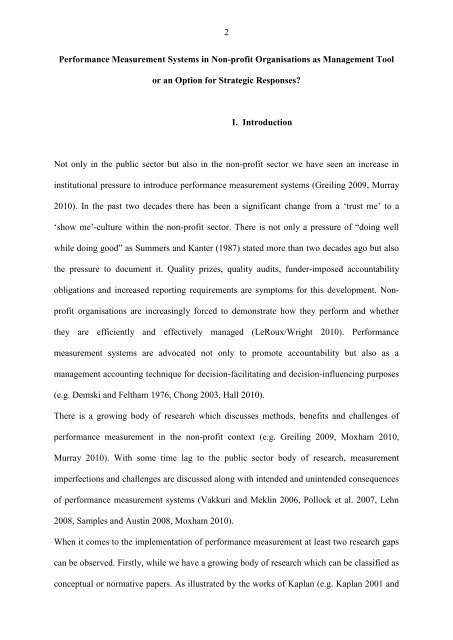Strategic responses to Performance Measurement in Nonprofit ...
Strategic responses to Performance Measurement in Nonprofit ...
Strategic responses to Performance Measurement in Nonprofit ...
You also want an ePaper? Increase the reach of your titles
YUMPU automatically turns print PDFs into web optimized ePapers that Google loves.
2<br />
<strong>Performance</strong> <strong>Measurement</strong> Systems <strong>in</strong> Non-profit Organisations as Management Tool<br />
or an Option for <strong>Strategic</strong> Responses?<br />
I. Introduction<br />
Not only <strong>in</strong> the public sec<strong>to</strong>r but also <strong>in</strong> the non-profit sec<strong>to</strong>r we have seen an <strong>in</strong>crease <strong>in</strong><br />
<strong>in</strong>stitutional pressure <strong>to</strong> <strong>in</strong>troduce performance measurement systems (Greil<strong>in</strong>g 2009, Murray<br />
2010). In the past two decades there has been a significant change from a „trust me‟ <strong>to</strong> a<br />
„show me‟-culture with<strong>in</strong> the non-profit sec<strong>to</strong>r. There is not only a pressure of “do<strong>in</strong>g well<br />
while do<strong>in</strong>g good” as Summers and Kanter (1987) stated more than two decades ago but also<br />
the pressure <strong>to</strong> document it. Quality prizes, quality audits, funder-imposed accountability<br />
obligations and <strong>in</strong>creased report<strong>in</strong>g requirements are symp<strong>to</strong>ms for this development. Non-<br />
profit organisations are <strong>in</strong>creas<strong>in</strong>gly forced <strong>to</strong> demonstrate how they perform and whether<br />
they are efficiently and effectively managed (LeRoux/Wright 2010). <strong>Performance</strong><br />
measurement systems are advocated not only <strong>to</strong> promote accountability but also as a<br />
management account<strong>in</strong>g technique for decision-facilitat<strong>in</strong>g and decision-<strong>in</strong>fluenc<strong>in</strong>g purposes<br />
(e.g. Demski and Feltham 1976, Chong 2003, Hall 2010).<br />
There is a grow<strong>in</strong>g body of research which discusses methods, benefits and challenges of<br />
performance measurement <strong>in</strong> the non-profit context (e.g. Greil<strong>in</strong>g 2009, Moxham 2010,<br />
Murray 2010). With some time lag <strong>to</strong> the public sec<strong>to</strong>r body of research, measurement<br />
imperfections and challenges are discussed along with <strong>in</strong>tended and un<strong>in</strong>tended consequences<br />
of performance measurement systems (Vakkuri and Mekl<strong>in</strong> 2006, Pollock et al. 2007, Lehn<br />
2008, Samples and Aust<strong>in</strong> 2008, Moxham 2010).<br />
When it comes <strong>to</strong> the implementation of performance measurement at least two research gaps<br />
can be observed. Firstly, while we have a grow<strong>in</strong>g body of research which can be classified as<br />
conceptual or normative papers. As illustrated by the works of Kaplan (e.g. Kaplan 2001 and
















